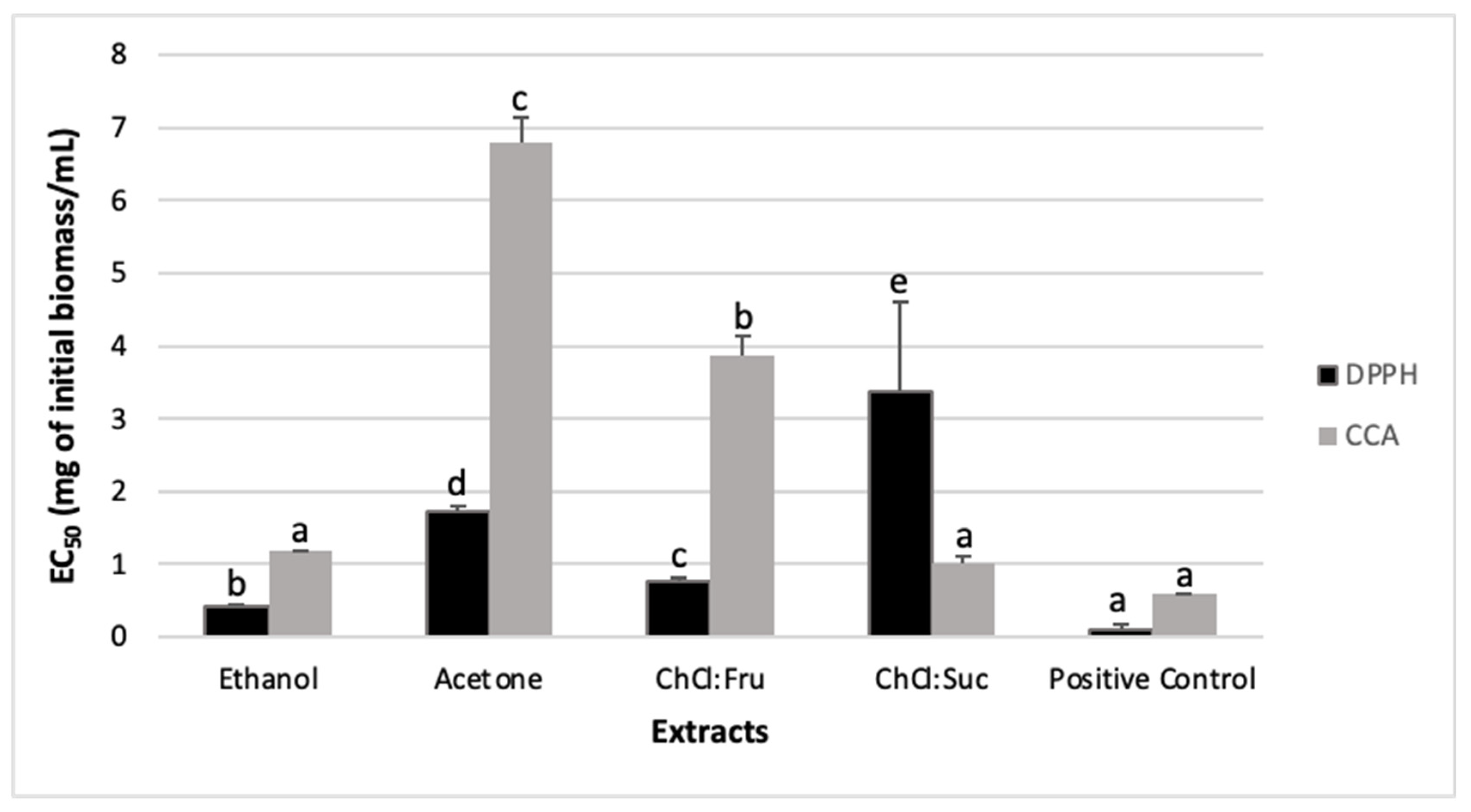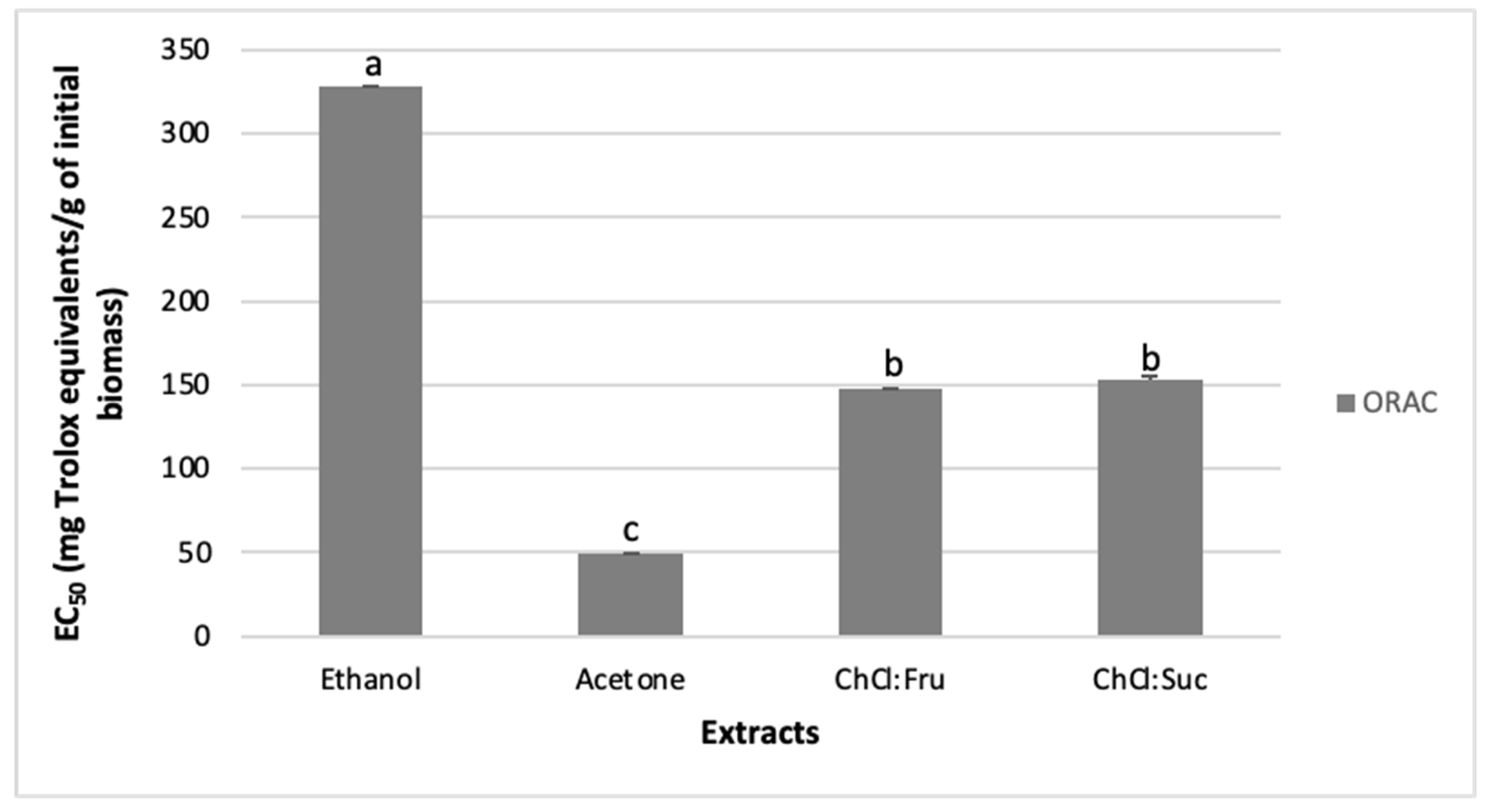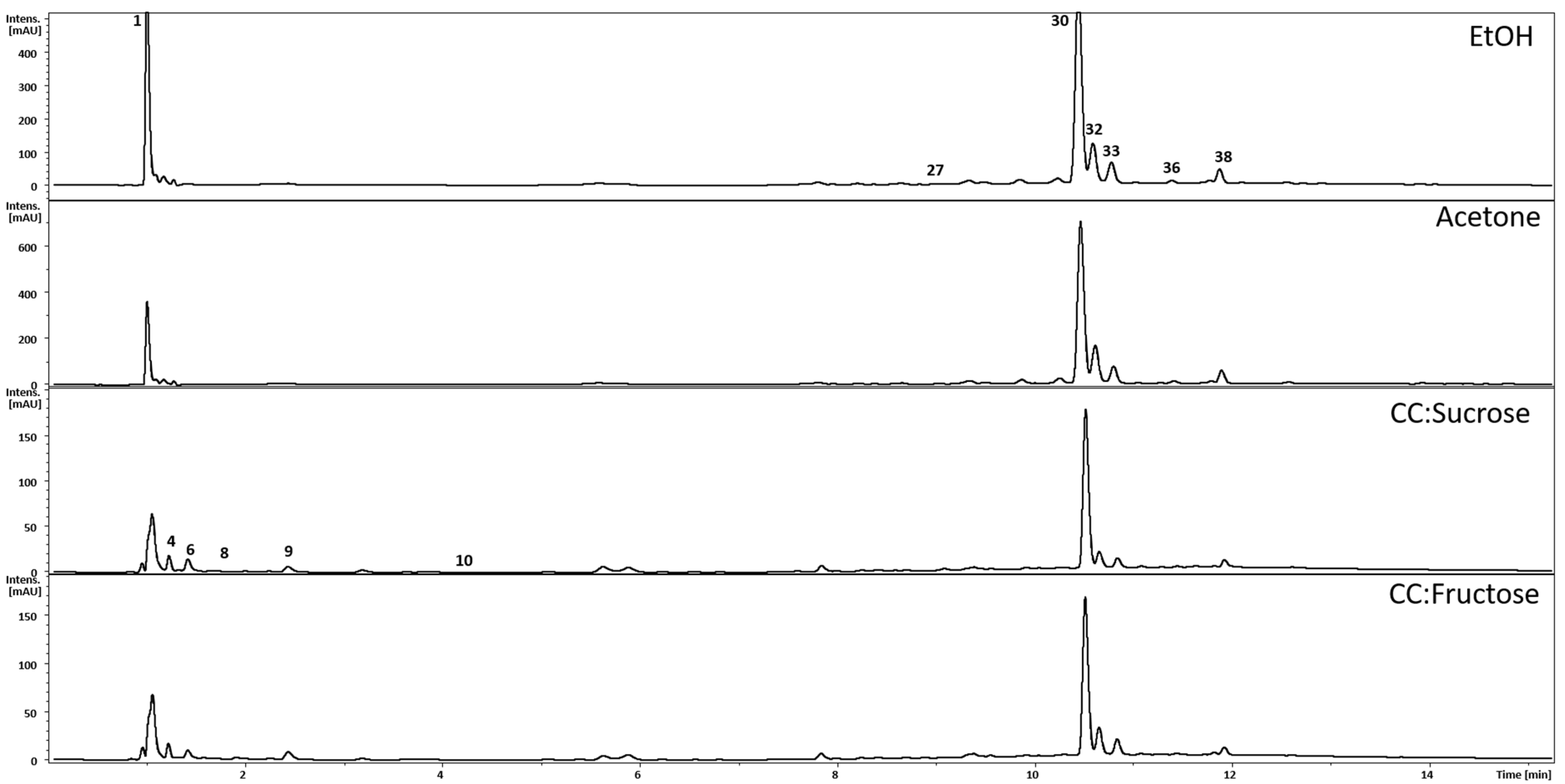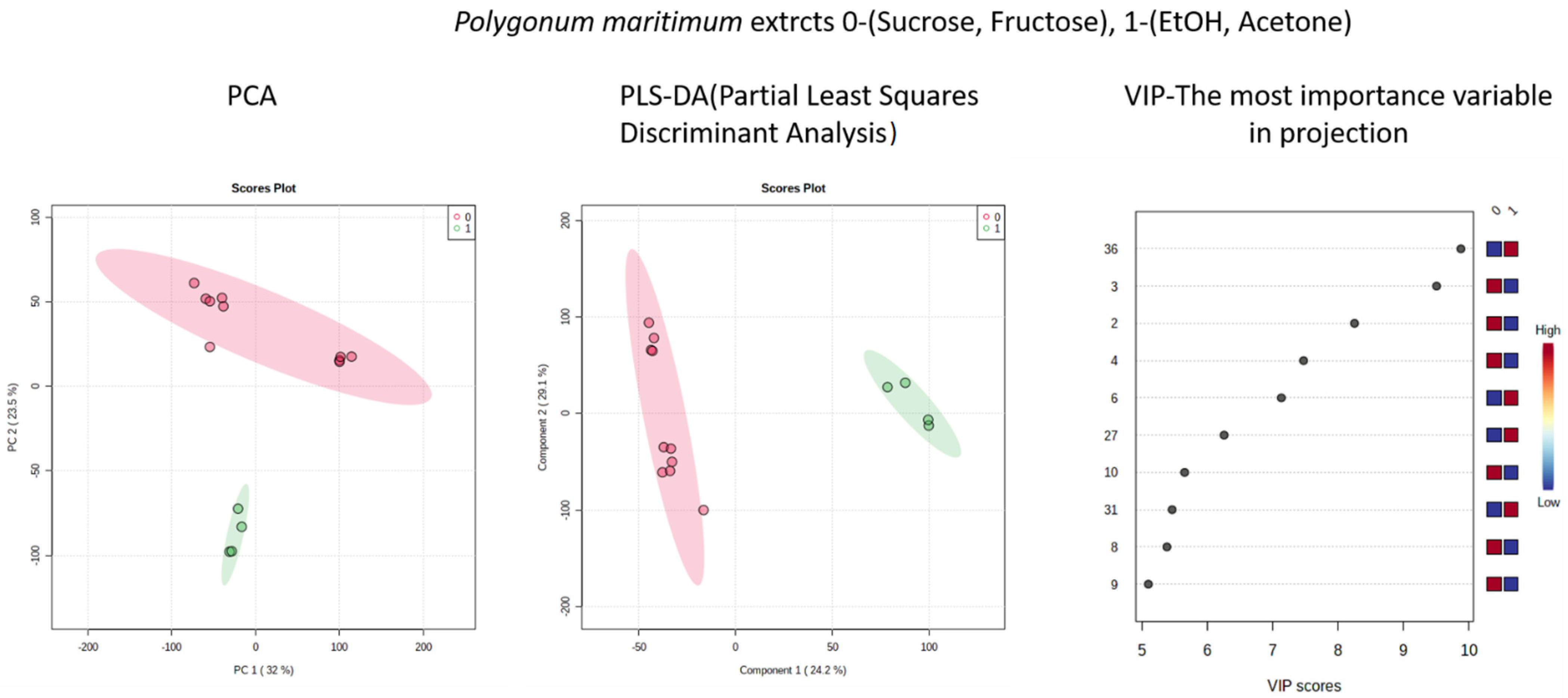Greener Is Better: First Approach for the Use of Natural Deep Eutectic Solvents (NADES) to Extract Antioxidants from the Medicinal Halophyte Polygonum maritimum L.
Abstract
:1. Introduction
2. Results and Discussion
2.1. Preparation and Optimization of NADES
2.2. In Vitro Antioxidant and Metal Chelating Properties
2.3. Phytochemical Characterization of Extracts
3. Materials and Methods
3.1. Chemicals
3.2. Plant Material
3.3. Conventional Extraction
3.4. Extraction Using NADES
3.4.1. Preparation of NADES
3.4.2. Extraction
3.5. Determination of In Vitro Antioxidant and Metal Chelating Properties
3.5.1. Radical Scavenging Activity (RSA) towards DPPH
3.5.2. ORAC Assay
3.5.3. CCA
3.6. Chemical Characterization of the Extracts
3.6.1. Sample Preparation
3.6.2. LC-(ESI)-QTOF-MS Analysis
3.6.3. LC-MS Data Processing and Compounds Annotation
3.7. Data Presentation and Statistical Analysis
4. Conclusions
Author Contributions
Funding
Institutional Review Board Statement
Informed Consent Statement
Data Availability Statement
Acknowledgments
Conflicts of Interest
Sample Availability
References
- Peng, X.; Duan, M.-H.; Yao, X.-H.; Zhang, Y.-H.; Zhao, C.-J.; Zu, Y.-G.; Fu, Y.-J. Green extraction of five target phenolic acids from Lonicerae japonicae Flos with deep eutectic solvent. Sep. Purif. Technol. 2016, 157, 249–257. [Google Scholar] [CrossRef]
- Ignat, I.; Volf, I.; Popa, V.I. A critical review of methods for characterisation of polyphenolic compounds in fruits and vegetables. Food Chem. 2011, 126, 1821–1835. [Google Scholar] [CrossRef]
- Paiva, A.; Craveiro, R.; Aroso, I.; Martins, M.; Reis, R.L.; Duarte, A.R.C. Natural deep eutectic solvents-solvents for the 21st century. ACS Sustain. Chem. Eng. 2014, 2, 1063–1071. [Google Scholar] [CrossRef]
- Anastas, P.; Eghbali, N. Green chemistry: Principles and practice. Chem. Soc. Rev. 2010, 39, 301–312. [Google Scholar] [CrossRef]
- Zoboli, R.; Paleari, S.; Speck, S.; Asquith, M. Towards a Green Economy in Europe. EU Environmental Policy Targets and Objectives 2010–2050; European Environment Agency: København, Denmark, 2013; Volume 8, pp. 1–48. [Google Scholar] [CrossRef]
- Berthod, A.; Ruiz-Angel, M.-J.; Carda-Broch, S. Ionic liquids in separation techniques. J. Chromatogr. A 2008, 1184, 6–18. [Google Scholar] [CrossRef] [PubMed]
- Bubalo, M.C.; Vidović, S.; Redovniković, I.R.; Jokić, S. Green solvents for green technologies. J. Chem. Technol. Biotechnol. 2015, 90, 1631–1639. [Google Scholar] [CrossRef]
- Mbous, Y.P.; Hayyan, M.; Hayyan, A.; Wong, W.F.; Hashim, M.A.; Looi, C.Y. Applications of deep eutectic solvents in biotechnology and bioengineering—promises and challenges. Biotechnol. Adv. 2017, 35, 105–134. [Google Scholar] [CrossRef] [PubMed]
- Bubalo, M.C.; Ćurko, N.; Tomašević, M.; Ganić, K.K.; Redovniković, I.R. Green extraction of grape skin phenolics by using deep eutectic solvents. Food Chem. 2016, 200, 159–166. [Google Scholar] [CrossRef]
- Panić, M.; Gunjević, V.; Radošević, K.; Bubalo, M.C.; Ganić, K.; Redovniković, I. COSMOtherm as an effective tool for selection of deep eutectic solvents based ready-to-use extracts from graševina grape pomace. Molecules 2021, 26, 4722. [Google Scholar] [CrossRef] [PubMed]
- Choi, Y.H.; van Spronsen, J.; Dai, Y.; Verberne, M.; Hollmann, F.; Arends, I.; Witkamp, G.-J.; Verpoorte, R. Are natural deep eutectic solvents the missing link in understanding cellular metabolism and physiology? Plant Physiol. 2011, 156, 1701–1705. [Google Scholar] [CrossRef] [PubMed] [Green Version]
- Wen, Q.; Chen, J.-X.; Tang, Y.-L.; Wang, J.; Yang, Z. Assessing the toxicity and biodegradability of deep eutectic solvents. Chemosphere 2015, 132, 63–69. [Google Scholar] [CrossRef] [PubMed]
- Obluchinskaya, E.; Pozharitskaya, O.; Zakharova, L.; Daurtseva, A.; Flisyuk, E.; Shikov, A. Efficacy of natural deep eutectic solvents for extraction of hydrophilic and lipophilic compounds from Fucus vesiculosus. Molecules 2021, 26, 4198. [Google Scholar] [CrossRef] [PubMed]
- Obluchinskaya, E.D.; Daurtseva, A.V.; Pozharitskaya, O.N.; Flisyuk, E.V.; Shikov, A.N. Natural deep eutectic solvents as alternatives for extracting phlorotannins from brown algae. Pharm. Chem. J. 2019, 53, 243–247. [Google Scholar] [CrossRef]
- Grillo, G.; Gunjević, V.; Radošević, K.; Redovniković, I.; Cravotto, G. Deep eutectic solvents and nonconventional technologies for blueberry-peel extraction: Kinetics, anthocyanin stability, and antiproliferative activity. Antioxidants 2020, 9, 1069. [Google Scholar] [CrossRef] [PubMed]
- Velásquez, P.; Bustos, D.; Montenegro, G.; Giordano, A. Ultrasound-assisted extraction of anthocyanins using natural deep eutectic solvents and their incorporation in edible films. Molecules 2021, 26, 984. [Google Scholar] [CrossRef] [PubMed]
- Panić, M.; Stojković, M.R.; Kraljić, K.; Škevin, D.; Redovniković, I.R.; Srček, V.G.; Radošević, K. Ready-to-use green polyphenolic extracts from food by-products. Food Chem. 2019, 283, 628–636. [Google Scholar] [CrossRef]
- Zhao, B.-Y.; Xu, P.; Yang, F.-X.; Wu, H.; Zong, M.-H.; Lou, W.-Y. Biocompatible deep eutectic solvents based on choline chloride: Characterization and application to the extraction of rutin from sophora japonica. ACS Sustain. Chem. Eng. 2015, 3, 2746–2755. [Google Scholar] [CrossRef]
- Nam, M.W.; Zhao, J.; Lee, M.S.; Jeong, J.H.; Lee, J. Enhanced extraction of bioactive natural products using tailor-made deep eutectic solvents: Application to flavonoid extraction from flos sophorae. Green Chem. 2015, 17, 1718–1727. [Google Scholar] [CrossRef]
- Bajkacz, S.; Adamek, J. Development of a method based on natural deep eutectic solvents for extraction of flavonoids from food samples. Food Anal. Methods 2018, 11, 1330–1344. [Google Scholar] [CrossRef] [Green Version]
- Bakirtzi, C.; Triantafyllidou, K.; Makris, D.P. Novel lactic acid-based natural deep eutectic solvents: Efficiency in the ultrasound-assisted extraction of antioxidant polyphenols from common native Greek medicinal plants. J. Appl. Res. Med. Aromat. Plants 2016, 3, 120–127. [Google Scholar] [CrossRef]
- Shikov, A.N.; Kosman, V.M.; Flissyuk, E.V.; Smekhova, I.E.; Elameen, A.; Pozharitskaya, O.N. Natural deep eutectic solvents for the extraction of phenyletanes and phenylpropanoids of rhodiola rosea L. Molecules 2020, 25, 1826. [Google Scholar] [CrossRef] [Green Version]
- Yang, G.-Y.; Song, J.-N.; Chang, Y.-Q.; Wang, L.; Zheng, Y.-G.; Zhang, D.; Guo, L. Natural deep eutectic solvents for the extraction of bioactive steroidal saponins from dioscoreae nipponicae rhizoma. Molecules 2021, 26, 2079. [Google Scholar] [CrossRef]
- EL Haci, I.A.; Bekkara, F.A.; Mazari, W.; Hassani, F.; Didi, M.A. Screening of biological activities of polygonum maritimum l. from algerian coast. Asian Pac. J. Trop. Biomed. 2013, 3, 611–616. [Google Scholar] [CrossRef] [Green Version]
- Edrah, S.; Kumar, S. Preliminary phytochemical and antibacterial studies of olea europaea and polygonum maritimum lib-yan plants. Int. J. Sci. Res. 2014, 3, 1677–1680. [Google Scholar]
- Rodrigues, M.J.; Custódio, L.; Lopes, A.; Oliveira, M.; Neng, N.R.; Nogueira, J.M.F.; Martins, A.; Rauter, A.P.; Varela, J.; Barreira, L. Unlocking the in vitro anti-inflammatory and antidiabetic potential of polygonum maritimum. Pharm. Biol. 2017, 55, 1348–1357. [Google Scholar] [CrossRef] [PubMed] [Green Version]
- Rodrigues, M.J.; Slusarczyk, S.; Pecio, Ł.; Matkowski, A.; Salmas, R.E.; Durdagi, S.; Pereira, C.G.; Varela, J.; Barreira, L.; Custódio, L. In vitro and in silico approaches to appraise polygonum maritimum L. as a source of innovative products with anti-ageing potential. Ind. Crop. Prod. 2018, 111, 391–399. [Google Scholar] [CrossRef]
- Rodrigues, M.J.; Matkowski, A.; Ślusarczyk, S.; Magné, C.; Poleze, T.; Pereira, C.; Custódio, L. Sea knotgrass (Polygonum maritimum L.) as a potential source of innovative industrial products for skincare applications. Ind. Crop. Prod. 2019, 128, 391–398. [Google Scholar] [CrossRef]
- Rodrigues, M.J.; Monteiro, I.; Placines, C.; Castañeda-Loaiza, V.; Ślusarczyk, S.; Matkowski, A.; Pereira, C.; Pousão-Ferreira, P.; Custódio, L. The irrigation salinity and harvesting affect the growth, chemical profile and biological activities of Polygonum maritimum L. Ind. Crop. Prod. 2019, 139, 111510. [Google Scholar] [CrossRef]
- Huntley, N.F.; Patience, J.F. Xylose: Absorption, fermentation, and post-absorptive metabolism in the pig. J. Anim. Sci. Biotechnol. 2018, 9, 4. [Google Scholar] [CrossRef] [Green Version]
- Chemat, F.; Vian, M.A.; Cravotto, G. Green extraction of natural products: Concept and principles. Int. J. Mol. Sci. 2012, 13, 8615–8627. [Google Scholar] [CrossRef] [Green Version]
- Workel, H.A. Quality and nutritional aspects of choline chloride. Krmiva 2004, 47, 101–106. [Google Scholar]
- Zeisel, S.H.; Mar, M.-H.; Howe, J.C.; Holden, J.M. Concentrations of choline-containing compounds and betaine in common foods. J. Nutr. 2003, 133, 1302–1307. [Google Scholar] [CrossRef]
- Institute of Medicine (US) Standing Committee on the Scientific Evaluation of Dietary Reference Intakes and its Panel on Folate, Other B Vitamins, and Choline. Dietary Reference Intakes for Thiamin, Riboflavin, Niacin, Vitamin B6, Folate, Vitamin B12, Pantothenic Acid, Biotin, and Choline; National Academies Press (US): Washington, DC, USA, 1998. [Google Scholar]
- Craig, S.A.S. Betaine in human nutrition. Am. J. Clin. Nutr. 2004, 80, 539–549. [Google Scholar] [CrossRef] [Green Version]
- Abbott, A.P.; Harris, R.C.; Ryder, K.S.; D’Agostino, C.; Gladden, L.F.; Mantle, M.D. Glycerol eutectics as sustainable solvent systems. Green Chem. 2011, 13, 82–90. [Google Scholar] [CrossRef]
- Sheldon, R.A. The E Factor: Fifteen years on. Green Chem. 2007, 9, 1273–1283. [Google Scholar] [CrossRef]
- PubChem. D-glucose compound. Available online: https://pubchem.ncbi.nlm.nih.gov/compound/GLUCOSE (accessed on 21 March 2020).
- PubChem. Sucrose. Available online: https://pubchem.ncbi.nlm.nih.gov/compound/Sucrose (accessed on 21 March 2020).
- Sigma Aldrich. Xylose. Available online: https://www.sigmaaldrich.com/catalog/product/sial/x1500?lang=pt®ion=PT (accessed on 21 March 2020).
- Radošević, K.; Ćurko, N.; Srček, V.G.; Bubalo, M.C.; Tomašević, M.; Ganić, K.K.; Redovniković, I.R. Natural deep eutectic solvents as beneficial extractants for enhancement of plant extracts bioactivity. LWT 2016, 73, 45–51. [Google Scholar] [CrossRef]
- Radošević, K.; Bubalo, M.C.; Srček, V.G.; Grgas, D.; Dragičević, T.L.; Redovniković, I.R. Evaluation of toxicity and biodegradability of choline chloride based deep eutectic solvents. Ecotoxicol. Environ. Saf. 2015, 112, 46–53. [Google Scholar] [CrossRef]
- Dai, Y.; van Spronsen, J.; Witkamp, G.-J.; Verpoorte, R.; Choi, Y.H. Natural deep eutectic solvents as new potential media for green technology. Anal. Chim. Acta 2013, 766, 61–68. [Google Scholar] [CrossRef]
- Liu, Y.; Li, J.; Fu, R.; Zhang, L.; Wang, D.; Wang, S. Enhanced extraction of natural pigments from Curcuma longa L. using natural deep eutectic solvents. Ind. Crop. Prod. 2019, 140, 111620. [Google Scholar] [CrossRef]
- Sirivibulkovit, K.; Nouanthavong, S.; Sameenoi, Y. Paper-based DPPH Assay for Antioxidant Activity Analysis. Anal. Sci. 2018, 34, 795–800. [Google Scholar] [CrossRef] [Green Version]
- Kedare, S.B.; Singh, R.P. Genesis and development of DPPH method of antioxidant assay. J. Food Sci. Technol. 2011, 48, 412–422. [Google Scholar] [CrossRef] [Green Version]
- Karadag, A.; Ozcelik, B.; Saner, S. Bioencapsulation of beta-carotene in three different methods. In Proceedings of the XVII International Conference on Bioencapsulation, Groningen, The Netherlands, 24–26 September 2009. [Google Scholar] [CrossRef]
- Maitra, I.; Marcocci, L.; Droy-Lefaix, M.T.; Packer, L. Peroxyl radical scavenging activity of Ginkgo biloba extract EGb 761. Biochem. Pharmacol. 1995, 49, 1649–1655. [Google Scholar] [CrossRef]
- Mylonas, C.; Kouretas, D. Lipid peroxidation and tissue damage. Vivo 1999, 13, 295–309. [Google Scholar]
- Wong, F.-C.; Yong, A.-L.; Ting, E.P.-S.; Khoo, S.-C.; Ong, H.-C.; Chai, T.-T. Antioxidant, metal chelating, anti-glucosidase activities and phytochemical analyses of selected tropical medicinal plants. Iran. J. Pharm. Sci. 2014, 13, 1409–1415. [Google Scholar]
- Baldari, S.; Di Rocco, G.; Toietta, G. Current biomedical use of copper chelation therapy. Int. J. Mol. Sci. 2020, 21, 1069. [Google Scholar] [CrossRef] [Green Version]
- Pal, C.B.T.; Jadeja, G.C. Deep eutectic solvent-based extraction of polyphenolic antioxidants from onion (Allium cepa L.) peel. J. Sci. Food Agric. 2019, 99, 1969–1979. [Google Scholar] [CrossRef]
- Shang, X.; Tan, J.-N.; Du, Y.; Liu, X.; Zhang, Z. Environmentally-friendly extraction of flavonoids from cyclocarya paliurus (Batal.) iljinskaja leaves with deep eutectic solvents and evaluation of their antioxidant activities. Molecules 2018, 23, 2110. [Google Scholar] [CrossRef] [PubMed] [Green Version]
- Kazantzoglou, G.; Magiatis, P.; Kalpoutzakis, E.; Skaltsounis, A.-L. Polygonophenone, the first mem-substituted natural product, from polygonum maritimum. J. Nat. Prod. 2009, 72, 187–189. [Google Scholar] [CrossRef]
- Nam, S.-H.; Park, J.; Jun, W.; Kim, D.; Ko, J.-A.; El-Aty, A.M.A.; Choi, J.Y.; Kim, D.-I.; Yang, K.-Y. Transglycosylation of gallic acid by using Leuconostoc glucansucrase and its characterization as a functional cosmetic agent. AMB Express 2017, 7, 1–10. [Google Scholar] [CrossRef] [Green Version]
- Rodrigues, M.J.; Soszynski, A.A.; Martins, A.; Rauter, A.P.; Neng, N.R.; Nogueira, J.M.F.; Varela, J.; Barreira, L.; Custódio, L. Unravelling the antioxidant potential and the phenolic composition of different anatomical organs of the marine halophyte Limonium algarvense. Ind. Crop. Prod. 2015, 77, 315–322. [Google Scholar] [CrossRef]
- Gillespie, K.M.; Chae, J.M.; A Ainsworth, E. Rapid measurement of total antioxidant capacity in plants. Nat. Protoc. 2007, 2, 867–870. [Google Scholar] [CrossRef]
- Chong, J.; Wishart, D.S.; Xia, J. Using metaboanalyst 4.0 for comprehensive and integrative metabolomics data analysis. Curr. Protoc. Bioinform. 2019, 68, e86. [Google Scholar] [CrossRef]




| HBA:HBD | Molar Ratio | Water Content | Stability * | Time/Temperature of Synthesis |
|---|---|---|---|---|
| ChCl:Fru | 1:2 | 30% | Stable | 15 min/50 °C |
| ChCl:Gluc | 1:2 | 30% | Unstable | 60 min/55 °C |
| ChCl:Xyl | 1:2 | 30% | Unstable | 55 min/55 °C |
| ChCl:Suc | 1:2 | 40% | Stable | 50 min/55 °C |
| No. | Compounds | tR | UV | m/z [M − H]− | Formula | MS2 Main-Ion | MS2 Fragments | Ethanol | Acetone | ChCl:Sucrose | ChCl:Fructose |
|---|---|---|---|---|---|---|---|---|---|---|---|
| 1 | 6-O-Galloyl-glucose | 0.9 | 272 | 331.0673 | C13H16O10 | 169.0110 | 271,211,151 | 82.14 | 113.515 | ||
| 2 | Sucrose | 1.0 | 341.1088, 387.1149 [M + FA] | C12H22O11 | 179.0519 | 161 | |||||
| 3 | Fructose | 1.0 | 179.0545, 225.0602 [M + FA] | C6H12O6 | 161.0421 | 149 | |||||
| 4 | Citric acid * | 1.2 | 209,272 | 191.0181 | C6H8O7 | 147.0322 | 127 | 0.58 | 0.12 | 1.107 | 0.95 |
| 5 | Gallate 3-glucosideE | 1.3 | 272 | 331.0667 | C13H16O10 | 169.0120 | 271,211,151,125 | 0.05 | 0.965 | ||
| 6 | Gallic acidE | 1.4 | 213 | 169.0137 | C7H6O5 | 125.0236 | 3.59 | 3.240 | 0.120 | 5.62 | |
| 7 | Acetyl-dihydroxyphenyl-D-glucopyranosideE | 1.5 | 275 | 329.0869 | C14H18O9 | 167.0328 | 152,283 | 0.182 | 0.333 | ||
| 8 | EpigallocatechinE | 1.9 | 277 | 305.0661 | C15H14O7 | 167.0326 | 219,179,261,237 | 2.30 | 5.919 | 0.365 | 0.84 |
| 9 | Methylgallic acid-O-sulphateE | 2.5 | 257 | 262.9864 | C8H8O8S | 183.0289 | 3.17 | 2.16 | |||
| 10 | CatechinE | 4.4 | 275 | 289.0704 | C15H14O6 | 245.0798 | 203,221,151,137,125 | 0.84 | 2.336 | 0.09 | |
| 11 | D-threo-HexitolE | 4.8 | 276 | 293.1232 | C12H22O8 | 131.0691 | 0.134 | 0.25 | |||
| 12 | EpicatechinE | 5.2 | 275 | 289.0706 | C15H14O6 | 245.0805 | 203,151,137,125 | 0.91 | 0.840 | 0.593 | 0.66 |
| 13 | Caffeic acid 3-sulfateE | 5.6 | 306 | 258.9906 | C9H8O7S | 179.0330 | 135 | 1.21 | 0.881 | 0.236 | 0.14 |
| 14 | p-Coumaric acid-glucosideE | 5.8 | 279 | 325.0932 | C15H18O8 | 163.0376 | 119 | 1.18 | 1.001 | 0.570 | 1.19 |
| 15 | Epigallocatechin-epicatechin 3-O-gallateE | 7.4 | 277 | 745.1413 | C37H30O17 | 305.0652 | 423,161,125 | 1.58 | 1.178 | 1.251 | 0.15 |
| 16 | Coumaroylquinic acidE | 7.6 | 275 | 337.0933 | C16H18O8 | 191.0540 | 173,163 | 0.422 | |||
| 17 | Coumaroylquinic acidE | 7.8 | 275 | 337.0921 | C16H18O8 | 191.0542 | 173,163 | 0.947 | 0.434 | 0.25 | |
| 18 | Epigallocatechin gallateE | 7.9 | 275 | 457.0776 | C22H18O11 | 169.0117 | 305,125 | 0.86 | 0.417 | 0.210 | 0.22 |
| 19 | Gallocatechin gallateE | 8.2 | 276 | 457.0779 | C22H18O11 | 169.0120 | 305,125 | 0.68 | 1.285 | 1.273 | 0.44 |
| 20 | Ethylgallate sulfateE | 8.4 | 277 | 277.0010 | C9H10O8S | 197.0436 | 182 | 0.31 | 0.430 | 0.620 | |
| 21 | Ent-Epicatechin-ent-epicatechin 3-gallateE | 8.5 | 274 | 729.1454 | C37H30O16 | 289.0708 | 269,125,407,169,433 | 0.428 | |||
| 22 | Myricetin-galloylglucosideF | 8.7 | 273 | 631.0944 | C28H24O17 | 479.0826 | 316,169 | 1.49 | 1.174 | 0.513 | 0.30 |
| 23 | Dihydroferulic acid 4-O-glucuronideE | 8.9 | 371.0977 | C16H20O10 | 249.0596 | 175,121 | 0.180 | 0.18 | |||
| 24 | Ent-Epicatechin-ent-epicatechinE | 9.2 | 577.1349 | C30H26O12 | 289.0690 | 407,125,161,245,381 | 0.55 | 0.443 | 0.341 | 0.23 | |
| 25 | Ent-Epicatechin-ent-epicatechin 3-gallateE | 9.3 | 729.1457 | C37H30O16 | 289.0708 | 269,125,407,169,433 | 2.00 | 2.684 | 0.983 | ||
| 26 | Myricetin 3′-glucosideF | 9.5 | 479.0833 | C21H20O13 | 316.0221 | 1.43 | 0.675 | 0.39 | |||
| 27 | Quercetin 3-(2′′-galloylglucoside)F | 9.9 | 615.0994 | C28H24O16 | 463.0878 | 300,313,271,241,169 | 2.01 | 3.744 | 0.736 | 0.32 | |
| 28 | Nepetin 4′-glucosideF | 10.0 | 477.1036 | C22H22O12 | 313.0553 | 433,169,163 | 0.27 | 0.357 | 0.16 | ||
| 29 | Gossypetin 8-O-glucosideF | 10.2 | 479.0832 | C21H20O13 | 317.0290 | 169 | 2.38 | 5.326 | 0.807 | 0.32 | |
| 30 | Myricetin 3-O-rhamnosideF | 10.4 | 218,263,351 | 463.0889 | C21H20O12 | 316.0230 | 300 | 62.71 | 96.190 | 23.852 | 18.71 |
| 31 | Epicatechin-3-gallateE | 10.5 | 262, 354 | 441.0844 | C22H18O10 | 169.0124 | 289,245,125 | ||||
| 32 | Quercetin-3-O-galactoside | 10.6 | 262, 355 | 463.0885 | C21H20O12 | 300.0276 | 12.26 | 24.270 | 3.234 | 3.66 | |
| 33 | Quercetin-3-O-glucosideF | 10.8 | 265, 352 | 463.0891 | C21H20O12 | 300.0275 | 5.74 | 10.412 | 2.398 | 1.96 | |
| 34 | Catechin 3-O-rutinosideE | 11.1 | 278 | 597.1838 | C27H34O15 | 357.0983 | 387,417,315,459,239 | 0.01 | 0.07 | ||
| 35 | NI | 11.2 | 449.2036 | C27H30O6 | 269.1387 | 209 | 0.13 | ||||
| 36 | Quercetin 7-xylosideF | 11.4 | 274 | 433.0784 | C20H18O11 | 300.0270 | 0.68 | 1.408 | 0.16 | ||
| 37 | Rhamnetin 3-galactosideF | 11.8 | 275, 351 | 477.1042 | C22H22O12 | 315.0494 | 299,462 | 0.43 | 0.596 | 1.470 | |
| 38 | QuercitrinF | 11.9 | 272, 348 | 447.0937 | C21H20O11 | 300.0272 | 284,255 | 3.91 | 7.597 | 0.343 | 0.94 |
| 39 | NI | 12.3 | 415.1991 | 161.0418 | 179 | 0.61 | 0.843 | 0.237 | 0.40 | ||
| 40 | MyricetinF | 12.5 | 276 | 317.0302 | C15H10O8 | 178.9978 | 151,137,287 | 0.31 | 0.842 | 0.310 | 0.01 |
| 41 | NI | 12.7 | 583.1100 | 300.0269 | 463 | ||||||
| 42 | NI | 12.8 | 471.0569 | C22H16O12 | 193.0127 | 301,319,178,257 | 0.11 | ||||
| 43 | Myricetin O-glucopyranosideF | 12.9 | 277 | 479.0827 | C21H20O13 | 317.0296 | 0.13 | 0.290 | |||
| 44 | Dihydroxyflavanone-sulfateF | 13.2 | 367.0148 | C15H12O9S | 287.0548 | 151,135 | 0.29 | 0.140 | |||
| 45 | NI | 13.4 | 347.0764 | C17H16O8 | 165.0169 | 211,137 | |||||
| 46 | Hydroxyflavanone-sulfateF | 13.5 | 351.0160 | C15H12O8S | 271.0600 | 151 | 0.10 | 0.137 | |||
| 47 | Trihydroxyflavanone-sulfateF | 13.6 | 383.0075 | C15H12O10S | 303.0503 | 151 | 0.07 | 0.139 | |||
| 48 | QuercetinF | 14.9 | 369 | 301.0347 | C15H10O7 | 151.0012 | 179,273,255,229 | 0.19 | 0.281 | ||
| 49 | IsorhamnetinF | 15.6 | 315.0503 | C16H12O7 | 300.0272 | 271,255 | 0.09 | 0.328 | |||
| 50 | Dihydroxy-8-oxooctadec-12-enoate | 17.1 | 327.2176 | C18H32O5 | 211.1332 | 229,291,171 | |||||
| 51 | Trihydroxy-9-octadecenoic acid | 18.1 | 329.2329 | C18H34O5 | 211.1327 | 229,283,311,171 |
Publisher’s Note: MDPI stays neutral with regard to jurisdictional claims in published maps and institutional affiliations. |
© 2021 by the authors. Licensee MDPI, Basel, Switzerland. This article is an open access article distributed under the terms and conditions of the Creative Commons Attribution (CC BY) license (https://creativecommons.org/licenses/by/4.0/).
Share and Cite
Rukavina, I.; Rodrigues, M.J.; Pereira, C.G.; Mansinhos, I.; Romano, A.; Ślusarczyk, S.; Matkowski, A.; Custódio, L. Greener Is Better: First Approach for the Use of Natural Deep Eutectic Solvents (NADES) to Extract Antioxidants from the Medicinal Halophyte Polygonum maritimum L. Molecules 2021, 26, 6136. https://doi.org/10.3390/molecules26206136
Rukavina I, Rodrigues MJ, Pereira CG, Mansinhos I, Romano A, Ślusarczyk S, Matkowski A, Custódio L. Greener Is Better: First Approach for the Use of Natural Deep Eutectic Solvents (NADES) to Extract Antioxidants from the Medicinal Halophyte Polygonum maritimum L. Molecules. 2021; 26(20):6136. https://doi.org/10.3390/molecules26206136
Chicago/Turabian StyleRukavina, Iva, Maria João Rodrigues, Catarina G. Pereira, Inês Mansinhos, Anabela Romano, Sylwester Ślusarczyk, Adam Matkowski, and Luísa Custódio. 2021. "Greener Is Better: First Approach for the Use of Natural Deep Eutectic Solvents (NADES) to Extract Antioxidants from the Medicinal Halophyte Polygonum maritimum L." Molecules 26, no. 20: 6136. https://doi.org/10.3390/molecules26206136
APA StyleRukavina, I., Rodrigues, M. J., Pereira, C. G., Mansinhos, I., Romano, A., Ślusarczyk, S., Matkowski, A., & Custódio, L. (2021). Greener Is Better: First Approach for the Use of Natural Deep Eutectic Solvents (NADES) to Extract Antioxidants from the Medicinal Halophyte Polygonum maritimum L. Molecules, 26(20), 6136. https://doi.org/10.3390/molecules26206136











